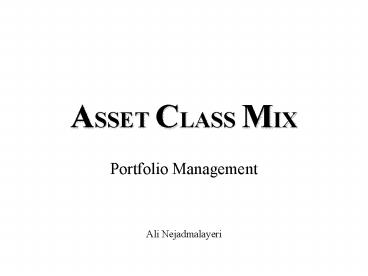ASSET CLASS MIX PowerPoint PPT Presentation
1 / 23
Title: ASSET CLASS MIX
1
ASSET CLASS MIX
- Portfolio Management
- Ali Nejadmalayeri
2
Strategic Asset Allocation
- To maximize return given investors risk
tolerance - Choose the appropriate asset class(es)
- Determine the expected return over the planning
period - Find the the efficient frontier
- Select the optimal portfolio
3
Expected Returns
- Given an asset class, investor construct
expectation about returns using - Historical information
- Assumes history is sufficient to predict future
- Forecasting methods
- Assumes other information than simple history is
needed to predict future
4
Historical Data
- If average past behavior is representative, then
expected return is the historical average! - Avg. T-bill yield is 3.70 (1926-1993)
- If average past behavior conditioned on
circumstances is relevant, then expected return
is the historical conditional average! - Avg. T-bill yield in an inflationary period
(1966-1980) is 5.70.
5
Scenario Forecasting
- Predict what happens in different scenarios
- Economic analysis
- Capital market analysis
- Interest rate behavior
- Asset returns
- Establishing probabilities
6
Scenario Forecasting Process
7
Determine Scenarios
- Economic conditions, e.g., GNP growth and
inflation regimes combined can help
8
Capital Markets
- Find out how asset prices (return) behave in
different economic scenarios (states) - For returns for instance
9
Optimal Portfolio
- Given scenarios and capital market implications
of that, then we use the techniques discussed in
Chapter 2 to determine the optimal mix. - Here, the conditional returns, risk and
correlation should be used instead - Note that average return across scenarios is
simply probability weighted average, but variance
is probability squared weighted of variances. We
assume that different scenarios occur independent
of each other
10
Scenario vs. Historical
- Imagine for stocks and bonds, historically we
had - However, forecast says
11
Scenario vs. Historical
- To guarantee an expected return of 8
- Based on historical, optimal portfolio should
have 57 stocks and 43 bonds, with an expected
return of 8 and standard deviation of 4.61. - Based on scenario forecast, optimal portfolio
should have 37 stocks and 63 bonds, with an
expected return of 8 and standard deviation of
19.42.
12
Construct Scenarios
- Use time-series of data for macro factors to
define states of the economy and find the
overall likelihood of occurrence of each state - Determine the average, volatility and
cross-correlation of different asset classes for
different environment
13
Allocation and the Economy
- Use a specific allocation, determine the expected
return and volatility of a portfolio of assets
for each of the states - Use historical likelihoods or some subjectively
forecasted ones to determine the overall expected
return and volatility - Optimize the weights such that overall
performance is optimized
14
Return, Risk States
- Imagine N states of nature with likelihoods of p1
,, pN and returns of R1 ,, RN then
15
Tactical Asset Allocation
- In scenario analysis, the optimal portfolio is
determined based on long-term forecast, whereas
Tactical Asset Allocation (TAA) attempts to use
short-term subtleties - In previous example, if we think that bad
state occurs immediately (likelihood of one for
next three months) then we should allocate 29 to
stocks and 71 to bonds!
16
TAA guidelines
- Using forecast models to predict the distribution
of market return change - Given the forecasted change, adjust beta of
portfolio so that reward to risk ratio is same as
long-run expectations. - In forecasting market behavior, the most
difficult task is to time the tactical
equity-cash shifts accurately
17
Managing Sensitivity
- Say long-run expected return is 13, std. dev. is
18, and T-bill yield is 6. Then long-run
reward to risk is - If short-term market return deviation, E(D), is
expected to be 1.6 then portfolio beta should
be changed to - of its current level, so if beta is 0.95 now then
it should be changed to 0.73
18
Market Cycles
- Core of market timing is predicting cycles right
and act on that information appropriately. - Cycles differ in length and severity
- The longer the cycle is the more beneficial
equity-cash shifts are
19
Forecasting Market
- The prevalent techniques are
- Valuation-based methods
- Business cycle monetary indicators
- Technical indicators
20
Valuation Indicators
- Risk premium, market return minus T-bill yield,
is the key indicator - RP and expected market return are positively
related when RP is high, E(RM) is high! - Implied probabilities of states of nature
- Reversing the process of forecasting, use
forecast of return to determine what
probabilities market assigns to events! - Options can be used for this purpose too!
21
Economic Indicators
- GNP gap
- GNP ? ? E(RM) ?
- Interest rate change
- Tbill ? ? E(RM) ? Var(RM) ?
- growth in money supply
- M1 ? ? E(RM) ? Var(RM) ?
- Inflation
- CPI ? ? E(RM) ? Var(RM) ?
- Others Liquidity, P/E ratio, Housing , etc.
- Refer to Flannery and Protopapadakis (2002)
Review of Financial Studies
22
Technical Indicators
- Trend lines
- Direction of market movement
- Moving Averages
- Relative market movement to historical ones
- Stochastic Oscillators
- Reveals cycles of stock movements
- And, Many Many Many others!
23
Asset Mix Strategies
- Buy-and-Hold
- Constant-Mix
- Constant-Proportion Portfolio Insurance

